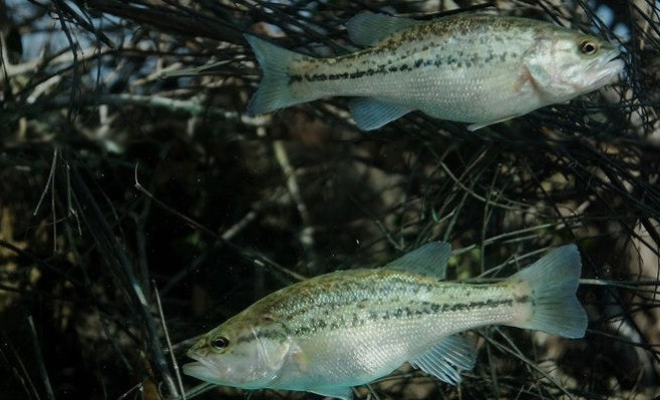We get it–huge, trophy-caliber bass is everyone’s dream gamefish to have in their pond. They put up a fantastic fight, taste great, and are the all-around classic gamefish for Texas ponds and lakes. But, there’s a catch. Largemouth Bass can be exceptionally difficult to manage correctly, especially in smaller ponds. They are voracious eaters and spawners, and when you couple that with only a small area of water, proper management poses a challenge. Instead of that trophy fish we all dream about, you are more likely to end up with a bunch of dinks.
I know what you’re thinking–”Then what the heck do I do? Not stock fish at all?” In which I am pleased to tell you…there are several more gamefish options for small ponds that will produce the same “wow” factor you’re looking for! Let’s meet the top contenders:
Hybrid Catfish–
A cross between a female Channel and a male Blue Catfish, the Hybrid Catfish boasts rapid growth rates and ultra-aggression on rod and reel. They are the top meat producing option for smaller ponds, so if your goal is fish as a food source, look no further. Producing a clean, white meat without any off-flavor typical to other catfish, Hybrid Cats have such an excellent feed conversion rate–they can basically eat a pound of bait or pellets and gain close to a pound in mass. In the aquaculture world, that’s pretty impressive! When fed with supplemental high-protein fish pellets, these little guys can put on up to 5 pounds in just one year. They like to eat, and their aggression is unmatched compared to other catfish. Hybrid Cats swim higher in the water column than traditional breeds, and thus have been known to actively hit topwater lures in addition to a wide array of other baits.
Hybrid Striped Bass–
For the anglers that really want bass fishing in their small pond, these beauties are the answer. Hybrid Striped Bass are a cross between a White Bass and a Striped Bass, and man do they live up to the hype. These fast fish are extremely comparable to Largemouth when fishing, as they hit topwater lures and live bait with nothing but sheer force. Known to be a bit more elusive than Largemouth, they are a great challenge for seasoned anglers. They produce a very flavorful meat as well, and typically get larger than traditional Largemouth strains when managed properly. In addition, Hybrid Stripers can stay on pelleted feed their whole life unlike Largemouth strains, which rarely consume pellets after being introduced to live bait. This characteristic makes Hybrid Stripers a more controllable species to grow to trophy level, and can be done in smaller areas of water.
Hybrid Crappie–
For the fisherman that truly enjoys Crappie fishing and all it has to offer, there’s a small pond option for you, too! Hybrid Crappie, which are a cross between a White Crappie and a Black Crappie, are a fast-growing, hardy alternative to traditional Black Crappie. They top out at around 1.5-3.0 pounds in recreational ponds, and the meat they produce is phenomenal. They carry all the aggression of purebred Crappie, just without the management headaches. These guys thrive with structure like straight Black or White Crappie, so are a great option for smaller ponds with existing trees, habitat, piers, or rocks.
Hybrid Perch–
Quite literally the “be-all-end-all” option for the pond owner that has a simple goal–a perch pond! Hybrid Perch are a cross between a Bluegill and a Green Sunfish, and are known for their accelerated growth rates and exceptional aggression. Due to the Green Sunfish influence, Hybrid Perch have larger mouths than Bluegill, meaning that they are able to consume a wider array of bait species. Hybrid Perch are another species that has a higher feed conversion rate compared to other fish, and does very well on pelleted feeds as well. Hybrid Perch are a perfect option for smaller ponds fished mainly by young anglers because they are quick to grow, are extremely hardy, and will go after anything that moves if it fits in their mouth. The aggression of Hybrid Perch is no joke, however, so if you’re planning on swimming in a pond stocked with Hybrid Perch getting used to some “love bites” is a necessity. (Pro tip, don’t wear anything shiny underwater!)
Despite all of these gamefish options having some cool features and great characteristics, one factor always gets addressed. Reproduction (or lack thereof). It’s true, yes, that hybrid species generally are not able to reproduce. Of the fish listed above, the only reported reproduction has been observed in the Hybrid Catfish and (rarely) in the Hybrid Perch. However, this is NOT a bad thing!
You see, when you have a small pond and want healthy gamefish, having species that don’t reproduce (or do so very rarely) makes that goal achievable. The reproduction aspect of traditional gamefish like Largemouth Bass and Crappie is the main reason why they are so hard to manage. Every pond or lake has a certain carrying capacity of fish–for example’s sake, we’ll say this number is 100 pounds of bass. That can be 100 one-pound bass, 50 two-pound bass…and so and so forth. In a larger pond or lake, culling practices and bait stocking practices are much more manageable due to the extra space. In a small pond, you’re fighting an uphill battle. Hybrid species with little to no reproduction ensure that your small pond will never get overrun and filled with stunted gamefish, bait stockings will be much more conducive to your time (and your wallet), and that you will still have the thrill of a lifetime catch at the end of the day.
If you have specific questions about the species we discussed, remember we are always available to help you! Shoot us an email or give the office line a call at 361-798-5934 and we will be more than happy to assist you. Tight lines, y’all!
Author: Jordan Moore
